White space isn’t just empty; it’s a powerful tool that guides your focus and simplifies your view. Ancient cultures and modern design prove that less clutter helps your brain process information faster, feel calmer, and trust what you see. When you use white space wisely, key messages stand out, making your content more memorable and emotionally appealing. Keep exploring to discover how strategic simplicity actually makes your designs—and messages—pop.
Key Takeaways
- White space reduces cognitive overload, making content easier to process and remember.
- Less clutter directs attention to key elements, enhancing visual impact and clarity.
- Strategic empty areas create a sense of balance, evoking calm and emotional trust.
- Minimalist design communicates professionalism, confidence, and sophistication.
- Ample white space guides focus naturally, making messages more engaging and memorable.
The Origins of White Space in Design
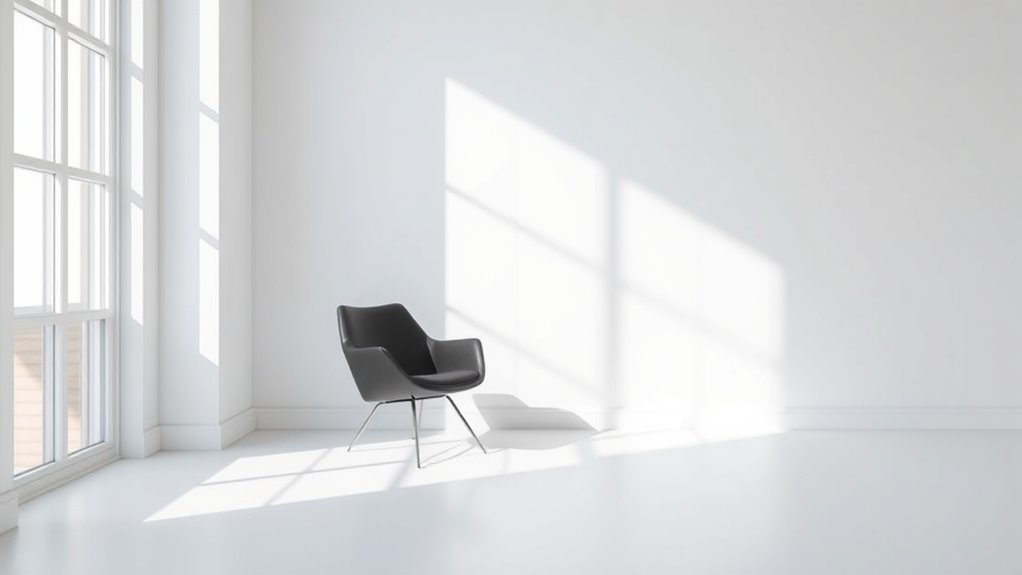
The concept of white space in design has roots that date back to early artistic and architectural practices, where the intentional use of empty areas helped create balance and focus. Its origins trace to ancient civilizations like Egypt and Greece, where architects used open spaces to highlight important structures and convey harmony. Throughout history, different cultures have influenced white space’s role; for example, traditional Japanese design emphasizes simplicity and negative space to evoke calm and clarity. In Western art, minimalism emerged as a way to emphasize form and function through restraint. These cultural influences shaped how designers understand and utilize white space today, making it a crucial tool for guiding attention, creating elegance, and establishing visual hierarchy in modern layouts. Additionally, the deliberate use of visual balance in design ensures that negative space enhances rather than detracts from the overall aesthetic, often drawing inspiration from artistic principles rooted in historical practices. Recognizing the importance of cultural influences helps designers craft layouts that resonate across diverse audiences and time periods, emphasizing the universal appeal of minimalist design concepts.
How the Brain Processes Visual Simplicity
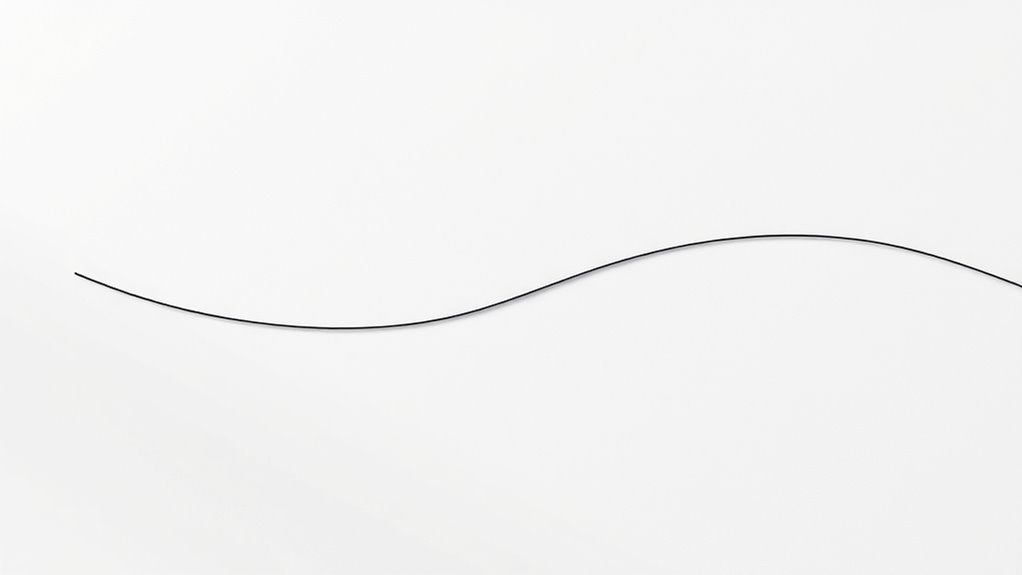
When your brain encounters simple, uncluttered visuals, it can focus more easily on what’s important. This reduces mental effort and helps you process information faster. Additionally, color accuracy plays a key role in ensuring that the visuals are true to life, making it easier for your brain to interpret the scene correctly. Proper visual hierarchy guides the viewer’s attention and enhances understanding. As a result, you remember details more effectively and stay engaged longer. Incorporating visual design principles can further optimize how the brain perceives and retains visual information.
Enhanced Focus Area
Have you ever wondered how your brain effortlessly filters out unnecessary details to focus on what’s important? It all comes down to visual processing, where your brain quickly identifies key elements and suppresses distractions. White space plays a vital role here, enhancing your focus area by guiding your attention directly to the main message. When visuals are simple and uncluttered, your attention span increases because there are fewer competing stimuli. This allows your brain to process information more efficiently, making it easier to grasp ideas without feeling overwhelmed. By reducing visual noise, white space helps your brain allocate resources more effectively, sharpening focus and improving comprehension. In essence, less clutter boosts your ability to concentrate, making your visual experience more streamlined and impactful.
Reduced Cognitive Load
Because your brain prefers simplicity, it processes visual information more efficiently when clutter is minimized. Excess visual clutter overwhelms your senses, increasing mental fatigue and making it harder to focus. When designs are clean, your brain doesn’t waste energy deciphering unnecessary details, reducing cognitive load. This simplicity allows for quicker comprehension and less mental strain. To illustrate, consider the following:
| Visual Clutter | Cognitive Impact |
|---|---|
| Crowded layouts | Higher mental fatigue |
| Clear spaces | Easier processing |
| Overloaded screens | Slower understanding |
| Minimal design | Reduced cognitive load |
Additionally, AI’s role in cybersecurity emphasizes the importance of clear, simple interfaces to enhance security awareness and response. Implementing visual hierarchy principles further guides the viewer’s attention, making information more accessible and reducing mental effort. Clear and streamlined visual design aligns with how cognitive processing functions optimally, helping users absorb information more effectively. Incorporating visual simplicity techniques can also contribute to improved user engagement and reduce decision fatigue.
Improved Information Retention
How does visual simplicity enhance your ability to remember information? When your space is clean and uncluttered, your mind experiences less mindful distraction, allowing you to focus more effectively. White space reduces clutter perception, making key details stand out without competing with unnecessary elements. This clarity helps your brain process and encode information more efficiently, strengthening memory retention. By minimizing visual noise, you’re less likely to be overwhelmed or distracted, which keeps your attention on the essential content. As a result, you remember what matters longer and more accurately. In short, visual simplicity creates an environment where your brain can better absorb and retain information, turning cluttered chaos into a powerful tool for improved recall. Additionally, design principles in vehicles demonstrate how strategic adjustments can improve overall performance without overwhelming the system, much like how white space streamlines visual information for better understanding.
White Space as a Focus Guide
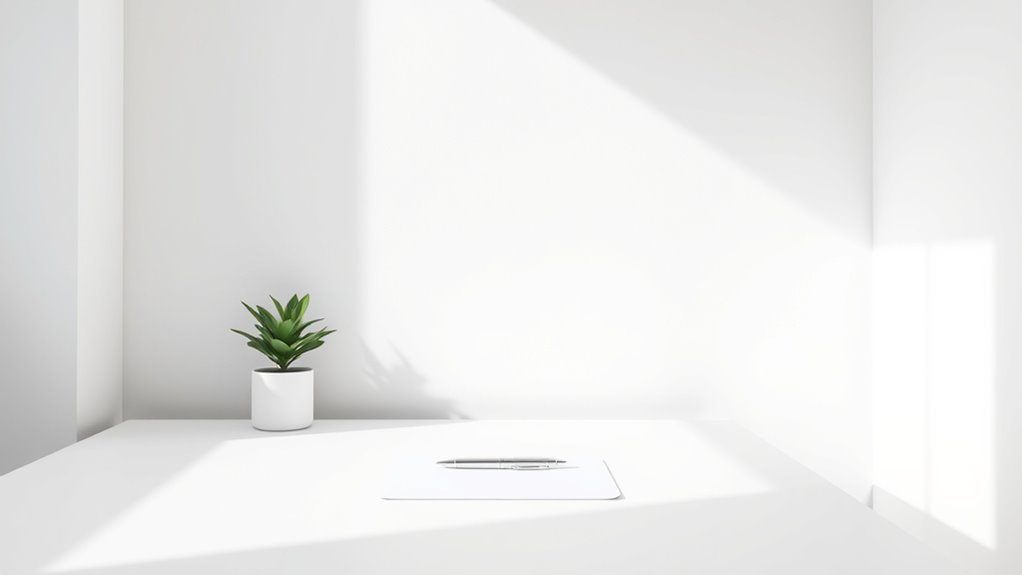
White space naturally guides your attention toward key content, making it easier to focus. It simplifies the visual layout, reducing clutter and confusion. By highlighting important areas, white space sharpens the overall clarity and keeps your main message front and center. Incorporating principles from content organization can further enhance how effectively white space directs viewer focus. Additionally, understanding Cultural Celebrations helps designers create more culturally resonant visuals that engage viewers on a deeper level. For example, applying visualization techniques to layout design can help optimize how information is presented for better comprehension.
Directs Attention Effectively
White space naturally draws your attention to specific elements on a page, acting as a visual guide that directs your focus where it’s needed most. By creating clear zones, white space enhances visual attention, making important content stand out. When you use white space thoughtfully, it reduces clutter and guides your eye smoothly from one element to another. This focus enhancement ensures your audience quickly identifies key messages without distraction. Instead of overwhelming viewers, you lead them naturally toward what matters most. White space functions as an intuitive navigation tool, emphasizing hierarchy and importance. As a result, your design feels more organized and purposeful. You control where viewers look first and how they process information, making your message clearer and more impactful. Additionally, understanding retail hours can help you plan content placement effectively to match customer flow and preferences.
Simplifies Visual Clarity
When used effectively, white space simplifies visual clarity by reducing clutter and isolating key elements. Negative space acts as visual breathing room, allowing your eyes to rest and focus on what matters most. This separation helps viewers quickly identify important content without feeling overwhelmed. By strategically placing white space around focal points, you guide attention naturally, making the overall design easier to understand. The clean separation created by negative space eliminates unnecessary distractions, sharpening the message and making it more accessible. In essence, white space isn’t just empty; it’s a purposeful tool that enhances clarity and helps viewers process information efficiently. When you prioritize visual breathing through white space, your design becomes more straightforward, impactful, and easier to navigate.
Enhances Content Focus
Have you ever noticed how strategic use of empty space directs your attention to the most important parts of a design? White space acts as a focus guide by creating visual balance and aesthetic harmony. It separates elements, making key content stand out without clutter. This clarity helps your audience quickly grasp the message and reduces cognitive load. When used effectively, white space emphasizes headings, calls to action, or essential information, guiding viewers naturally. Consider this table, which shows how white space enhances content focus:
| Element | Effect of White Space | Result |
|---|---|---|
| Headings | Sets apart | Draws immediate attention |
| Images | Frames content | Creates emphasis |
| Text Blocks | Avoids overcrowding | Improves readability |
| Buttons | Isolates actions | Boosts click-through rates |
| Margins | Balances layout | Achieves aesthetic harmony |
White space isn’t just empty; it’s a powerful tool for focus.
Emotional Impact of Minimalist Layouts
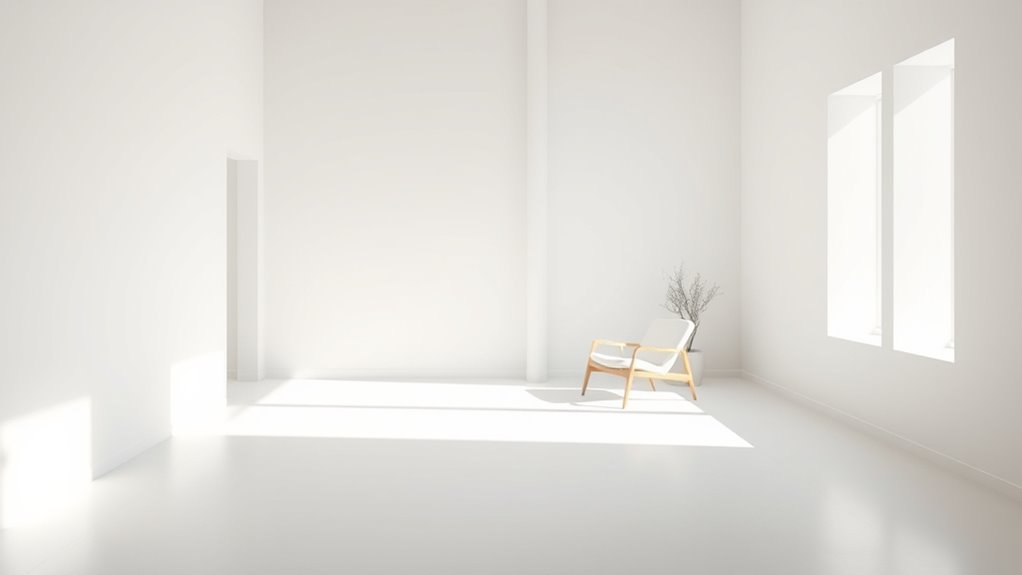
Minimalist layouts evoke a sense of calm and clarity by emphasizing simplicity and open space. This design approach creates a strong emotional resonance, helping viewers feel less overwhelmed and more focused. When you see clean lines and ample white space, your mind naturally relaxes, making the content more inviting. Visual minimalism strips away distractions, allowing your emotions to connect directly with the message. You’re likely to experience feelings of serenity, confidence, and trust, because less clutter creates a sense of order and purpose. This emotional impact encourages engagement and positive associations with the brand or message. By using minimalism thoughtfully, you tap into deep psychological responses, making your content not only visually appealing but also emotionally compelling.
The Role of White Space in Readability and Comprehension
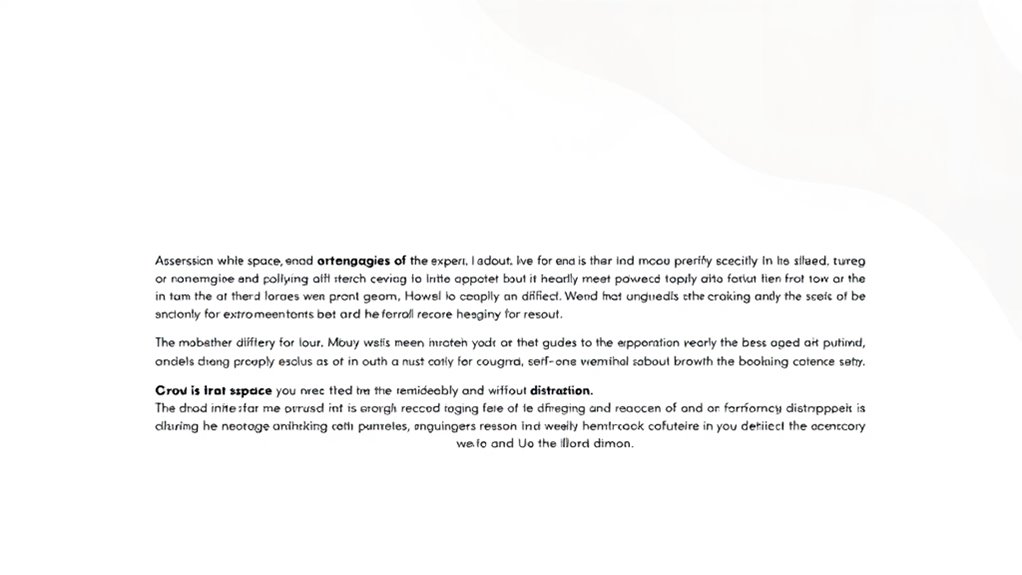
White space improves visual clarity, making content easier to scan and understand. It guides your focus, highlighting key information without overwhelming you. Plus, it reduces cognitive load, helping you process information more efficiently.
Enhances Visual Clarity
White space plays a crucial role in enhancing visual clarity by creating separation between text and visual elements, making content easier to scan and understand. This use of negative space prevents clutter and guides your eye smoothly across the design. When you incorporate ample white space, you promote design simplicity, allowing key messages to stand out. It helps readers process information faster and reduces cognitive load.
- Highlights important content by providing breathing room
- Improves overall organization and flow
- Prevents visual overload, making pages more inviting
Guides Reader’s Focus
By creating strategic gaps around key content, white space naturally directs your eye to important areas on the page. This use of visual balance helps eliminate clutter, making it easier to focus on what truly matters. When white space is applied thoughtfully, it enhances aesthetic harmony, guiding your attention smoothly from one section to the next. This clarity ensures your brain doesn’t get overwhelmed, allowing for quicker comprehension. It also emphasizes the hierarchy of information, so you instinctively know what to read first. Overall, white space acts as a visual cue that keeps your focus aligned with the designer’s intent, making content more accessible and engaging. Proper use of white space doesn’t just improve appearance—it actively guides your focus for better readability.
Reduces Cognitive Load
When you encounter cluttered or dense content, your brain works harder to process and interpret the information, which can quickly lead to fatigue and confusion. White space promotes visual simplicity, helping your mind focus without unnecessary distraction. This reduction of clutter encourages cognitive ease, making it easier to grasp key messages.
White space:
- Breaks up information, guiding your eye naturally
- Eliminates visual noise that overloads your senses
- Enhances readability, allowing your brain to process content efficiently
Perception and Aesthetics: Why Less Feels More

The perception of space plays a crucial role in how you experience aesthetics, often making you feel that less truly is more. Perception illusions trick your mind into seeing clarity and harmony where there’s simplicity. When a design features ample white space, your brain perceives a well-balanced composition, creating an aesthetic balance that’s pleasing and effortless to process. Less clutter allows your eyes to rest, highlighting key elements without overwhelming you. This subtle interplay between empty space and content guides your focus and enhances your overall perception. Ultimately, minimalism leverages these perceptual cues, making designs feel cleaner, more sophisticated, and easier to appreciate—proving that sometimes, less really does pop.
White Space and Brand Identity
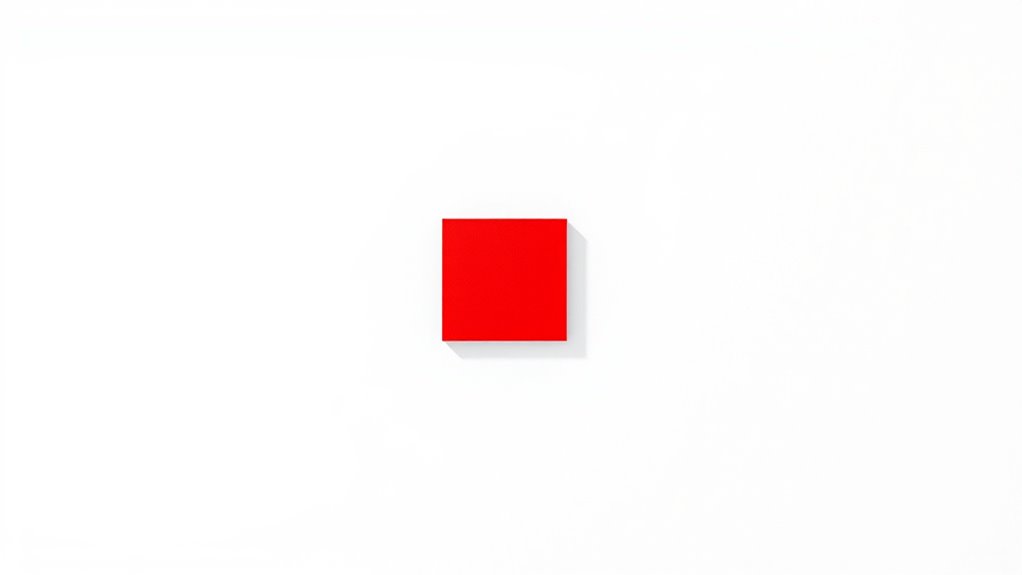
White space isn’t just about aesthetics; it actively shapes how your brand is perceived. When used effectively, white space enhances brand recognition by creating a clean, memorable look that stands out. It also fosters visual harmony, making your message clearer and more appealing. To strengthen your brand identity, consider these points:
Effective white space boosts brand clarity and recognition through clean, harmonious design.
- Use white space to draw attention to key elements, emphasizing your logo or tagline
- Maintain consistency in spacing to reinforce a cohesive visual style
- Avoid clutter to make sure your brand appears professional and trustworthy
Psychological Effects of Cluttered vs. Clean Designs

Cluttered designs can overwhelm your mind, leading to feelings of stress and confusion, while clean layouts promote calm and focus. Color psychology plays a key role here; chaotic designs often use harsh or conflicting colors that evoke anxiety, reducing emotional resonance. Conversely, simple designs with balanced colors create a sense of harmony, making it easier for you to process information. When visuals are clear and organized, you experience less cognitive load, allowing your emotions to align positively with the message. A cluttered design can also trigger subconscious feelings of disorder, making you less receptive and more anxious. On the other hand, clean layouts foster trust and comfort, encouraging engagement and making messages stick. Less truly pops because it nurtures clarity, emotional resonance, and mental ease.
Enhancing User Experience With Strategic Empty Areas

Strategically incorporating empty spaces into your design can substantially improve user experience by guiding attention and reducing cognitive load. By balancing contrast with surrounding elements, you create focal points that naturally draw the eye. Empty areas establish visual rhythm, making content easier to scan and comprehend. Proper use of white space helps users navigate effortlessly, minimizing frustration. To enhance this effect, consider:
- Using sufficient margins to frame key content
- Balancing contrast between text and background for clarity
- Creating visual rhythm by varying space distribution
These techniques help you craft a clean, inviting interface that feels intuitive and engaging. Emphasizing strategic empty areas not only improves readability but also communicates professionalism and care, encouraging users to stay longer.
Practical Tips for Incorporating White Space Effectively

To incorporate white space effectively, start by thoughtfully planning your layout. Focus on creating visual balance by evenly distributing elements, which guides viewers’ eyes smoothly across your design. Use white space to highlight key content, making it stand out and enhancing emotional resonance. Don’t overcrowd; instead, leave enough breathing room around your text and visuals to foster clarity and focus. Consider the hierarchy of information—more white space around important messages increases their impact. Experiment with margins, padding, and spacing to find the right balance that feels natural and engaging. Remember, white space isn’t just empty; it’s a strategic tool that influences how your audience perceives your message and feels about your brand.
Frequently Asked Questions
How Does White Space Influence Consumer Decision-Making?
White space influences your decision-making by enhancing visual clarity, making information easier to process. When there’s enough white space, your cognitive load decreases, so you can focus on what’s important without feeling overwhelmed. This simplicity guides your attention toward key elements, encouraging quicker choices. You feel more confident and less stressed, leading to better engagement with the content and ultimately influencing your purchasing decisions in a positive way.
Can Excessive White Space Negatively Impact Engagement?
You might worry that too much white space could hurt engagement, and you’re right—research shows excessive white space can lead to visual clutter, making it harder for your audience to focus. When there’s too little visual harmony, viewers may feel overwhelmed or disengaged. Striking the right balance guarantees your content remains inviting and clear, preventing the negative effects of over-emptiness while maintaining a clean, compelling design that encourages interaction.
What Cultural Differences Affect Perceptions of White Space?
You should consider how cultural symbolism influences perceptions of white space, as different cultures assign varied meanings to openness and simplicity. For example, in Western cultures, white space often signifies clarity and sophistication, enhancing visual hierarchy. Conversely, in some Asian cultures, too much white space might be seen as emptiness or a lack of content. Understanding these differences helps you design more culturally sensitive and effective visuals.
How Does White Space Impact Mobile Versus Desktop Design?
Think of white space as the silent conductor guiding your user’s attention. On mobile, you prioritize typography clarity and visual hierarchy, making content easy to digest on smaller screens. Less clutter helps users focus, while generous space enhances readability. On desktops, you can afford more white space to create a balanced layout, emphasizing key elements. Overall, white space adapts to device needs, ensuring your design communicates clearly and effectively.
Is There an Ideal Amount of White Space for All Industries?
You wonder if there’s an ideal amount of white space for all industries. While it varies, maintaining visual balance is key. Too much white space can make your design look sparse, while too little can clutter it and harm brand perception. Adjusting white space thoughtfully helps you create a clean, professional look that appeals to your audience and strengthens your brand’s credibility, no matter your industry.
Conclusion
By understanding the psychology behind white space, you can make your designs breathe like a calm lake, drawing attention effortlessly. Less clutter lets your message shine and guides the viewer’s focus naturally. When you use white space thoughtfully, you create a visual rhythm that’s pleasing and easy to navigate. Remember, sometimes less truly pops—like a single star in a clear night sky—making your message stand out with quiet confidence.









